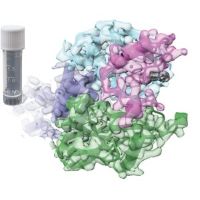Specification
| Organism | Homo sapiens (Human) |
| Expression Host | E.Coli |
| Tag Info | Tag-Free |
| Purity | >97% as determined by SDS-PAGE and HPLC. |
| Uniprot ID | P09341 |
| Uniprot Entry Name | GROA_HUMAN |
| Gene Names | CXCL1,GRO,GRO1,GROA,MGSA,SCYB1 |
| Alternative Names | C-X-C motif chemokine 1 Melanoma growth stimulatory activity, MGSA, Neutrophil-activating protein 3 |
| Expression Region | Full Length of Mature Protein (35-107aa) |
| Molecular Weight | 7.9 kDa |
| Endotoxin | Less than 1.0 EU/µg as determined by LAL method. |
| Sequence | ASVATELRCQ CLQTLQGIHP KNIQSVNVKS PGPHCAQTEV IATLKNGRKA CLNPASPIVK KIIEKMLNSD KSN |
| Product Form | Lyophilized powder (Lyophilized from a 0.2 μm filtered concentrated solution in 20 mM PB, pH 7.4, 50 mM NaCl.) |
| Reconstitution | Please reconstitute protein in deionized sterile water and we recommend that briefly centrifuge thevial prior to opening the vial .We recommend aliquot for long-term storage at -20℃/-80℃. |
Background
| Relevance | Has chemotactic activity for neutrophils. May play a role in inflammation and exerts its effects on endothelial cells in an autocrine fashion. In vitro, the processed forms GRO-alpha(4-73), GRO-alpha(5-73) and GRO-alpha(6-73) show a 30-fold higher chemotactic activity. {ECO:0000269|PubMed:10095777}. |
| Function | Has chemotactic activity for neutrophils. May play a role in inflammation and exerts its effects on endothelial cells in an autocrine fashion. In vitro, the processed forms GRO-alpha(4-73), GRO-alpha(5-73) and GRO-alpha(6-73) show a 30-fold higher chemotactic activity. |
| Involvement in disease | |
| Subcellular Location | Secreted |
| Protein Families | Intercrine alpha (chemokine CxC) family |
| Tissue Specificity | |
| Pathway | Chemokinesignalingpathway |
QC Data
| Note | Please contact us for QC Data |
| Product Image (Reference Only) |  |

